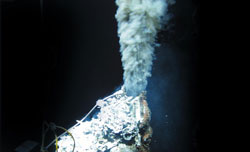DNA Running Hot and Cold

A new lab technique for replicating DNA may be reminiscent of the way the first such molecules on Earth copied themselves. In the 10 October PRL a team demonstrates DNA replication using convection currents to transport DNA molecules through changing temperatures. The experiment simulates conditions around volcanic ocean vents, say the researchers, and suggests that such temperature extremes may have been the key to the earliest attempts at reproduction.
A DNA molecule is made of two complementary strands that fit together like the two sides of a ladder. If the sides become separated, a polymerase protein can help each strand gather fragments of DNA floating nearby and assemble them into partner strands that stick to the originals, making two complete copies of the molecule. Theorists have suggested that early biological molecules similar to DNA may have been able to perform this procedure without help from an enzyme. But this replication process cannot occur if the temperature remains constant. The standard laboratory method for copying DNA requires many cycles of heating the apparatus above 90 degrees Celsius for the separation step and cooling below 60 degrees Celsius for the assembly step.
Recently researchers have proposed that volcanic vents in the ocean might have provided these temperature contrasts. Hot water spews from a vent and then cools quickly in the much colder ocean water, then sinks and heats up again. The circular current that results is called a convection cell. The replication may have occurred in smaller-scale convection cells that can form in cracks and chambers within nearby porous rock.
Dieter Braun of Rockefeller University in New York City and his colleagues demonstrated this scenario in the lab with a simple convection chamber. Using an infrared laser, they heated the center of a box filled with water, DNA, and polymerase. As the fluid heated, it flowed away from the center to the air-cooled outer edges of the box, and then cycled back to the hot center. As the DNA cycled through the different temperature zones, the molecule replicated at an exponentially increasing rate over several minutes. The team found that with a box about a centimeter large and thermostatically controlled heating, they could produce very smooth currents that seemed to be the most effective environment for DNA replication.
Roberto Piazza of Milan Polytechnic in Italy calls the Rockefeller team’s method “simple, ingenious, and elegant.” According to Mike Russell of the Scottish Environmental Research Center in Glasgow, “the Rockefeller group have leapfrogged” several stages of “cook and look” experiments, in which researchers try to simulate biochemical precursors of life. He says the experiment supports the view that ocean vents may have been the initial environment for the emergence of life. However, Robert Hazen of the Carnegie Institution of Washington and NASA’s Astrobiology Institute cautions that no one has proposed a plausible way for DNA or other biomolecules to “bootstrap” into self-replication without specialized enzymes.
–Kim Krieger
Kim Krieger is a freelance science writer in Norwalk, Connecticut.


